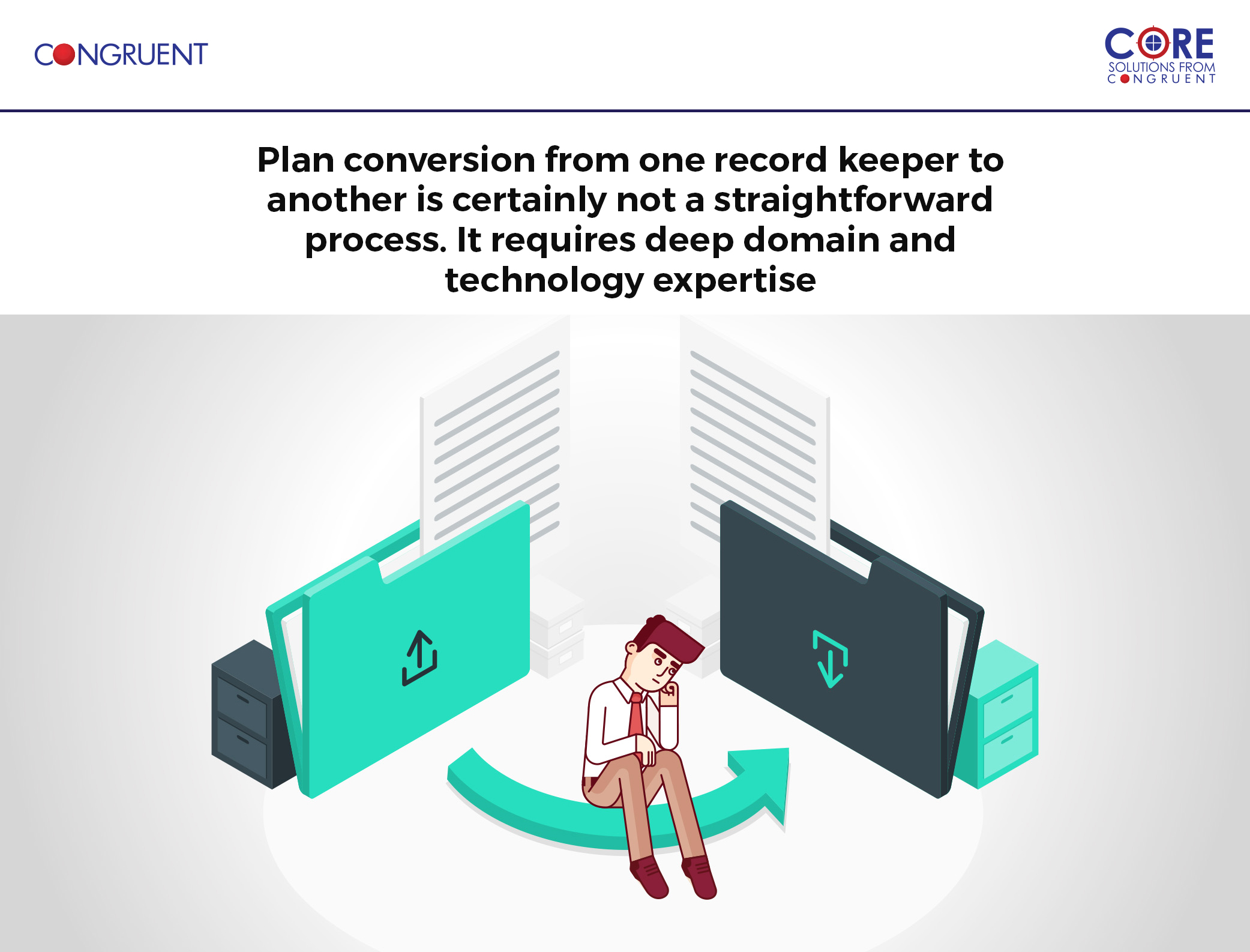
Plan Providers and Record keepers often face the scenario where they have to move plans from one platform to another. This process presents multiple challenges and needs to be planned to ensure that there are no disruptions in experience for Plan Sponsors and Plan Participants.
A large Plan Provider based in New York administered its retirement plans on a legacy record keeping system. The legacy platform was rigid and expensive to manage. They wanted to move to a cloud-based record keeping software. However, they found the process of plan conversion complex; consuming expensive resources and time.
The drivers for a plan conversion exercise could be many besides the above scenario, including:
- Plans changing from one provider to another
- Mergers and takeovers resulting in the need for consolidation of platforms
- Change of record keeping systems in a provider necessitating moving of plans
- Part transformation of some of the modules, resulting in co-existence of legacy systems with new age technologies
Challenges to Plan Conversion
Most Plan Providers offering Defined Contribution services have record keeping systems that have been around for decades with their own data storage systems and databases. Sometimes the data is stored in multiple formats and in multiple locations. Each department working with these databases has its own set of tools that were developed to cater to their specific needs. Consolidating the databases into one format can be a challenge involving complex data validation as well as data reconciliation.
Replicating the data is inefficient use of time and cost as it requires manual transfer of millions of records. Needless to say, this also increases the risk of introducing errors.
Other challenges to the transformation would be disruption to participant accounts, long periods of blackout and miscommunications.
Planning for a smooth conversion
The successful plan conversion requires three broad elements:
- A project plan
- Dataset Selection
- Input & Output Specifications
- Data Transformations
- Rule sets & Conversion
- Validation and Reporting
- An experienced team
- Subject Matter Experts
- QA
- Conversion Specialists
- A communications campaign
Other conversion requirements
Conversion can be a one-time activity or a periodic one to keep data consistent and accurate across platforms/systems. Periodic conversions are commonly done addressing specific plans/ books of business while the others stay on the older record keeping system.
In all conversion projects, the book of business that is being converted on each run also needs to be tracked. This can either be all the plans on the system or specific plans broken down by plan type/ similarity in specifications. Real time transformation of data between two or more systems can be facilitated by introducing APIs where possible.
Most often there are system dependencies forcing the order in which the data can be migrated into a system, and can vary for each system. The order of the data that comes in needs to be maintained to ensure key references downstream.
In every conversion run, the number of records, number of errors/ exceptions, control totals etc. would be tracked. This is followed by running reconciliation reports to ensure that all the data has moved from the source to the target. In case of any errors, the source data needs to be corrected and, if required, sponsors or other users will be approached to complete this activity.
At the end of most conversion projects, there is a parallel run/ testing period where transactions performed on both systems are expected to give identical results based on the data stored in them.
As plan conversions can take place either on a live system (system in production) or on a pre-production mode, a separate conversion environment is set up to check/ validate data.
Congruent Advantage
Congruent uses its own proprietary File Processor and Mapper tools that interfaces with existing databases to retrieve the required data and map it to the fields defined for the new systems. This eliminates the need for replicating databases, thereby being cost and time efficient. It has an in-built data validation engine, thereby reducing the possibility of errors. This can work with any database, thus making it a database-agnostic solution.
Congruent Solutions, the Retirement Specialist
Congruent Solutions is a leading technology solutions provider to the retirement plan administration industry with deep domain expertise and over two decades of industry experience. Security is at the core of Congruent’s operating philosophy, and the company’s security practices are in line with the best in the industry. It is a matter of great pride that we are one of the first companies in the world to be certified by KPMG with ISO 9001:2008 in the areas of Back Office Processing for Pension Administration. Our team of dedicated professionals deliver ground-breaking solutions which blend deep domain expertise with process-driven technological excellence.
Today, Congruent Solutions has achieved ISO 9001:2015 and ISO 27001:2013 certifications, and is SOC1 Type II and SOC2 Type II certified by independent third party auditors – all in recognition of the high standards for information security and management we follow.
The Congruent team can handle plan conversion from one third party record keeping system to another. Congruent’s suite of technology solutions for the retirement plan industry contains multiple data and business validations already available within the CORE services engine.
Also read as to how Congruent helped a Fortune 500 provider manage data on three different record keeping systems and transition plans to its CORE Payroll solution.
